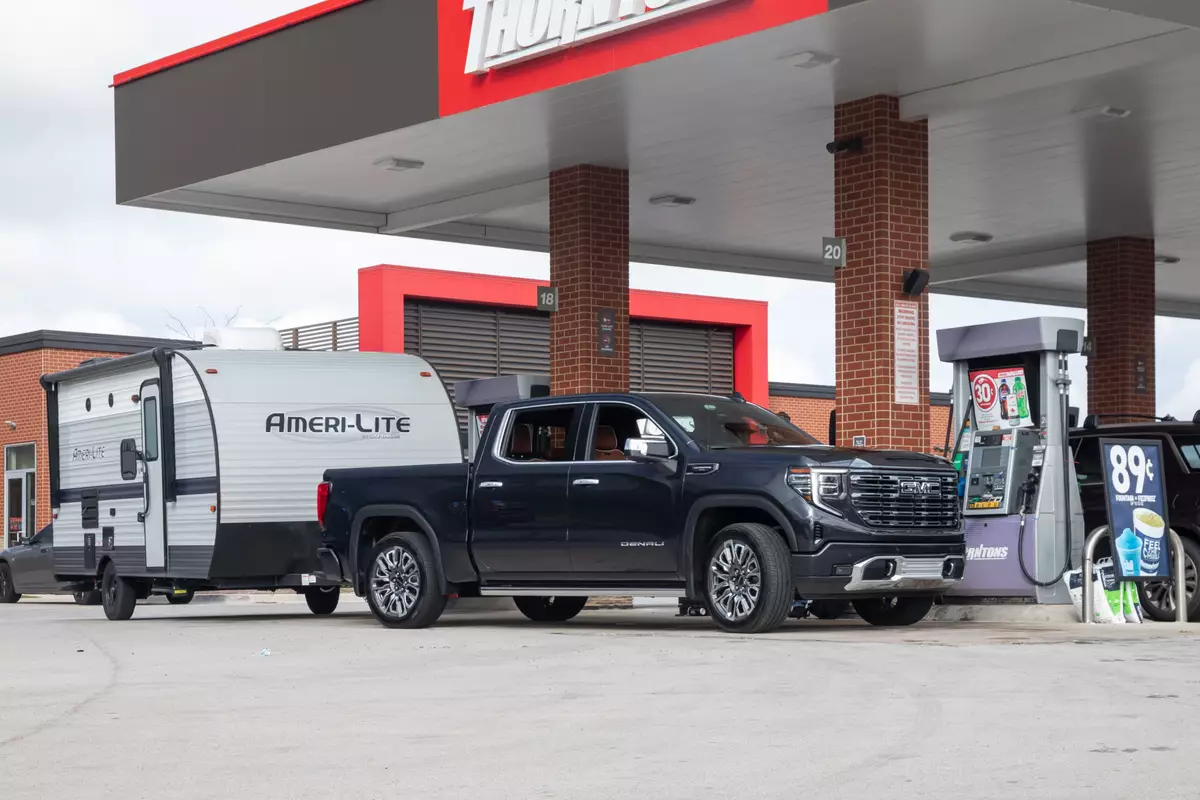2024 Full-Size Pickup Truck Challenge: Which Full-Size Pickup Truck Has the Best Real-World MPG?


The three pickup trucks in our full-size truck comparison test were very similarly priced, with only around $3,000 separating the least expensive truck from the most expensive one. Despite this pricing similarity, their powertrains were quite different.
2024 Full-Size Pickup Truck Challenge
Results | Winner | Towing | Acceleration and Braking | Real-World MPG
The Trucks
Representing the traditional pickup powertrain was the 2024 GMC Sierra 1500 Denali Ultimate. The GMC had a 6.2-liter V-8 engine under its hood paired with a 10-speed automatic transmission. Making 420 horsepower at 5,600 rpm and 460 pounds-feet of torque at 4,100 rpm, the GMC’s V-8 was by far the biggest engine in the test, but it was actually the least powerful of the three powertrains. The GMC’s EPA-estimated fuel economy is 15/19/16 mpg city/highway/combined.
Under the hood of the 2025 Ram 1500 Tungsten was the brand’s new high-output twin-turbocharged 3.0-liter inline-six-cylinder engine teamed with an eight-speed automatic. The new engine replaces Ram’s venerable 5.7-liter Hemi V-8 for the 2025 model year, and even though it’s considerably smaller than the outgoing Hemi, its output is much greater: 540 hp at 5,700 rpm and 521 pounds-feet of torque at 3,500 rpm in high-output form. The Ram’s EPA-estimated gas mileage is 15/21/17 mpg.
Powering the 2024 Ford F-150 Platinum was the brand’s PowerBoost hybrid system, which consists of a twin-turbo 3.5-liter V-6 engine paired with a 10-speed automatic transmission with an integral electric motor and a lithium-ion battery pack. Total system output is 430 hp at 6,000 rpm and 570 pounds-feet of torque at 3,000 rpm. The F-150 hybrid had the highest estimated gas mileage of the three trucks: 22/24/23 mpg.
Three different trucks, three different powertrains. We wanted to know: What gas mileage do they get in real-world driving?
Related Video:
The Route
To find out, we drove all three trucks on the same roughly 200-mile drive route — once without an attached trailer and again with a 20-foot, single-axle travel trailer hooked up. Our route largely consisted of interstate highways and rural two-lane roads in the suburbs and farming communities southwest of Chicago, so the fuel economy results here are more indicative of what the trucks can achieve on a road trip as opposed to city driving.
In order to minimize as many variables as possible, we follow some specific test procedures. We rotate drivers through each of the trucks at stops along the route to minimize differences in driving style, and we fill up the trucks at the beginning and end of the route using the same gas pump for consistency when crunching our calculated fuel-economy numbers. We also ask our drivers to follow some specific procedures, like keeping the windows up, not using cruise control and using the climate system’s Auto setting with their preferred cabin temperature. We kept each truck in two-wheel drive and used its Normal driving mode when not towing and Tow/Haul when towing.
The Results

We ran the fuel-economy route first without trailers, and at the end of the route, the F-150, perhaps not surprisingly, had the best observed gas mileage of 23.3 mpg. (Our observed fuel-economy numbers are an average of the truck’s trip computer and calculated gas mileage.) That’s spot on with the Ford’s combined mileage estimate, but the GMC and Ram weren’t that far behind with observed fuel economy of 21.5 and 21.0 mpg, respectively — considerably better than their combined estimates.
The observed fuel-economy differences between the trucks narrowed even more when we ran the route with travel trailers hitched to each of the trucks. The F-150 hybrid was the most efficient again, with observed gas mileage of 11.5 mpg, while the Sierra 1500 got 11.0 mpg and the Ram 1500 10.6 mpg. It’s worth noting that we were driving in exceptionally windy conditions during this portion of the test, with gusts approaching 30 mph.
So, what can you take away from these results? With a roughly 2-mpg difference between the most and least efficient truck when not towing, and less than a 1-mpg difference when towing a travel trailer, the spread just isn’t large enough to be a determining factor in which truck you buy. There were, however, greater differences in how the trucks performed in our drag-strip acceleration testing, as well as how confident they felt when towing, and you can see how the trucks stack up in these areas in the related stories linked above.
Cars.com’s Editorial department is your source for automotive news and reviews. In line with Cars.com’s long-standing ethics policy, editors and reviewers don’t accept gifts or free trips from automakers. The Editorial department is independent of Cars.com’s advertising, sales and sponsored content departments.

Mike Hanley has more than 20 years of experience reporting on the auto industry. His primary focus is new vehicles, and he's currently a Senior Road Test Editor overseeing expert car reviews and comparison tests. He previously managed Editorial content in the Cars.com Research section.
Featured stories




